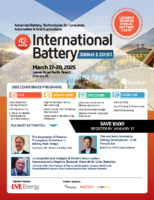詳細はお問い合わせください。
アジェンダ・講演者・スポンサー更新
40年以上もバッテリー技術をリード
最終アジェンダが利用可能
1983年に創設されたInternational Battery Seminar & Exhibitは、コンシューマー、自動車、軍事、電力網、産業アプリケーション向けに、世界のエネルギー貯蔵技術の最新動向を紹介する一流のイベントとして、その地位を確立しています。世界で最も長い歴史を持つ、バッテリー業界の年次イベントであるこの会議は、重要な開発や新製品を発表し、最先端のバッテリー技術を披露する場として常に高い人気を得ています。たとえば、ソニーは1991年に初めてリチウムイオン技術を発表する場としてInternational Battery Seminarを選び、この偉業はその後、世界を変えることになりました。
昨年のイベントには、主要OEM、セル製造業者、パックインテグレーター、コンポーネント開発企業、原材料サプライヤー、材料科学者など、先端のバッテリーサプライチェーンのあらゆるセグメントから、2,000人以上の著名なバッテリー技術者が参加しました。
›推薦の動画を見る
2025年に予定されているOEM・バッテリー開発企業(一部): 24M Technologies, Adden Energy, Amazon, American Battery Solutions, Amionx, Amprius, Anthro Energy, AVL, Blue Current, BMW, Clarios, Daimler, Doroni Aerospace, EVE Energy, Ford Motor Company, General Motors, Golden Gate Battery, Google, Hitachi High-Tech, Honeywell, Intel, Jaguar Land Rover, LG Energy Solution, Lucid Motors, Lyten, Maxell, Medtronic, Mercedes-Benz, Meta Platforms, Microsoft, Molicel, Northvolt, Nyobolt, Panasonic, Peak Energy, QuantumScape, REPT, SAFT, Sionic Energy, Solid Energies, SpaceX, Stellantis, Tesla, Texas Instruments, Toyota, UNIGRID Battery, UniverCell, Volexion, VTA Technology, and more.
































